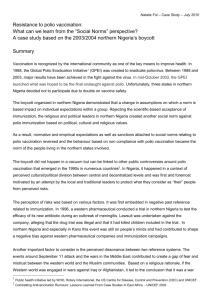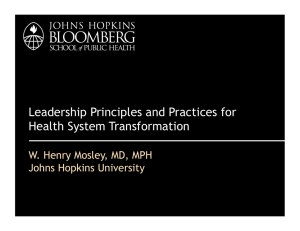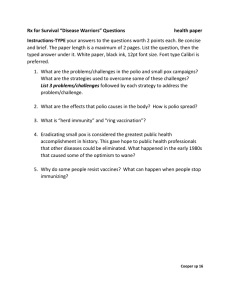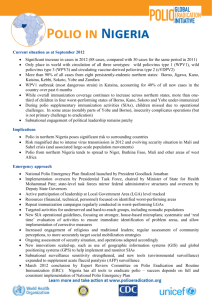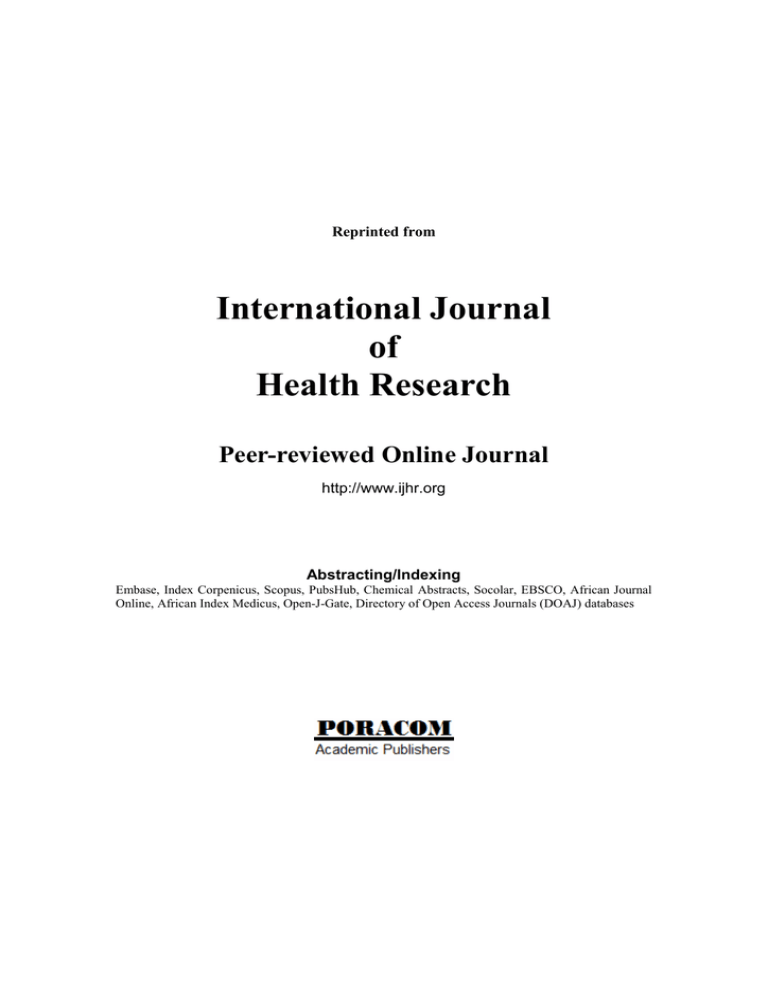
Reprinted from
International Journal
of
Health Research
Peer-reviewed Online Journal
http://www.ijhr.org
Abstracting/Indexing
Embase, Index Corpenicus, Scopus, PubsHub, Chemical Abstracts, Socolar, EBSCO, African Journal
Online, African Index Medicus, Open-J-Gate, Directory of Open Access Journals (DOAJ) databases
Yusufari et al
Improving child survival through cinema
International Journal of Health Research
The International Journal of Health Research is an online international journal allowing free unlimited access to
abstract and full-text of published articles. The journal is devoted to the promotion of health sciences and related
disciplines (including medicine, pharmacy, nursing, biotechnology, cell and molecular biology, and related
engineering fields). It seeks particularly (but not exclusively) to encourage multidisciplinary research and
collaboration among scientists, the industry and the healthcare professionals. It will also provide an international
forum for the communication and evaluation of data, methods and findings in health sciences and related
disciplines. The journal welcomes original research papers, reviews and case reports on current topics of special
interest and relevance. All manuscripts will be subject to rapid peer review. Those of high quality (not previously
published and not under consideration for publication) will be published without delay. The maximum length of
manuscripts should normally be 10,000 words (20 single-spaced typewritten pages) for review, 6,000 words for
research articles, 3,000 for technical notes, case reports, commentaries and short communications.
Submission of Manuscript: The International Journal of Health Research uses a journal management
software to allow authors track the changes to their submission. All manuscripts must be in MS Word and in
English and should be submitted online at http://www.ijhr.org. Authors who do not want to submit online or
cannot submit online should send their manuscript by e-mail attachment (in single file) to the editorial office
below. Submission of a manuscript is an indication that the content has not been published or under consideration for
publication elsewhere. Authors may submit the names of expert reviewers or those they do not want to review their papers.
Enquiries:
Enquiries:
The Editorial Office
International Journal of Health Research
Dean’s Office, College of Medicine
Madonna University, Elele Campus, Rivers State
E-mail: editor_ijhr@yahoo.com or editor@ijhr.org
PORACOM
Academic Publishers
International Journal of Health Research, October 2010; 3(3): 121-131
International Journal of Health Research, September 2011; 4(3): 123-122
Int J Health Res, September 2011; 4(3): 134
Yusufari et al
Improving child survival through cinema
International Journal of Health Research, September 2011; 4(3): 111-106
International Journal of Health Research, September 2011; 4(3): 135-141
© Poracom Academic Publishers. All rights reserved
.
Available at http://www.ijhr.org
Open Access
Original Research Article
Online Journal
Making Pictures Speak Louder than Voice: Efforts to
Improve Child Survival through ‘Majigi’ in Jigawa State,
Nigeria
Abstract
Purpose: This pilot study assessed the role of the motorcycle
cinema (Majigi) scheme in empowering local community members
with life-saving education to ultimately improve their well-being
and survival.
Methods: In December 2010, a total of 561 parents with children
under 5 years viewed a polio routine immunization (RI)
sensitization video across eight communities in Hadejia Local
Government Area. The ‘pre-’ and ‘post-video-exposure’ periods
were defined as the period before and after the viewers were shown
the video, respectively. Pre- and post-assessment interviews were
conducted using a structured questionnaire administered to 96
randomly selected viewers.
Results: Half of the respondents during the pre-video-exposure
period gave correct polio decision-making knowledge and this
increased significantly to 89% during the post-innovation period.
About 68% had positive attitudes towards their responsibility for
ending polio during the pre-assessment and increased significantly
to 89% during the post-assessment. Pre-video-exposure knowledge
of the RI schedule averaged 56% and increased to 88%.
Conclusion: Large and multi-focal approaches to address health
system challenges are critical in northern Nigeria. We hope that
these findings will further encourage program planners and policy
makers in northern Nigeria and similar settings in identifying and
utilizing novel methods to reach the poor and disadvantaged areas
in the quest to meet the Millennium Development Goals related to
maternal and child health by 2015.
Keywords: Child health; Health promotion; Immunization;
Maternal health; Nigeria.
Yusuf Yusufari1
Henry V Doctor2,3*
Salisu A Koki1
Isa M Surajo1
1
PRRINN-MNCH Program, Dutse, Jigawa State,
Nigeria.
2
Columbia University, Mailman School of Public
Health, Population & Family Health, New York,
USA.
3
PRRINN-MNCH Program, Nassarawa GRA,
Kano State, Nigeria
*For correspondence:
Tel: +234(0)7064236792
Email: hvd2105@columbia.edu
This article is available in Embase, Index Corpenicus, Scopus, PubsHub, Chemical Abstracts, Socolar, EBSCO, African
Journal Online, African Index Medicus, Open-J-Gate, Directory of Open Access Journals (DOAJ) databases
Int J Health Res, September 2011; 4(3): 135
Yusufari et al
Introduction
Northern Nigeria has some of the worst maternal
and child health indices in the world. The infant
mortality and under five mortality rates are 91
deaths and 217 deaths per 1,000 live births,
respectively [1]. Thus, 10% of infants and 22% of
young children are dying. Only 6% of children
are fully immunized and about 30% of children
have no vaccinations. At the national level, out of
every 100,000 deliveries 545 pregnant women die
and in the North the number is probably above
1,000 [1, 2]. This means that 1% of pregnant
women in the North die during pregnancy or
childbirth. Just under 10% of women have a
skilled birth attendant during delivery [1]. This
high level of maternal and child mortality in
Nigeria means that the country may be unable to
attain Millennium Development Goals (MDGs) 4
and 5 (i.e., reduction of child and maternal
mortality, respectively) by the year 2015.
In 2003, the immunization program in Nigeria
introduced activities that were geared towards
improving coverage of all the antigens in the
immunization schedule. In December 2004,
Nigeria adopted the Reaching Every Ward
approach during a National Review and Planning
meeting to strengthen routine immunization (RI)
in every ward. Activities include capacity
building for strengthening static services; reestablishing outreach and mobile services;
supportive supervision; linking services with
communities;
resource
management
and
mobilization; monitoring and evaluation,
including monitoring the impact of RI on vaccine
preventable diseases. In May 2006, the
Immunization Plus Days (IPDs) strategy was
introduced. The IPDs are supplementary
immunization
activities
aimed
at
(1)
administering oral polio vaccine to all children
under five years of age, irrespective of previous
doses, (2) reaching all previously unreached
eligible children, thus reducing substantially the
percentage of missed children, (3) strengthening
RI, and (4) administering other child survival
interventions (de-worming, ITN distribution,
vitamin A supplementation, anti-malarial drugs,
soaps) [1].
Improving child survival through cinema
Inadequate health facilities (coupled with weak
core management functionalities of staff,
finances, drugs, and equipment), lack of
transportation to institutional care, inability to
pay for services, and resistance among some
populations to modern health care are key factors
behind the country’s high rates of maternal,
newborn, and child morbidity and mortality
particularly in the north [3, 4]. These challenges
have led to severe collapse of health service
delivery among virtually all northern states. For
example, Jigawa was one of the states which
experienced a steady and progressively severe
deterioration in the organization and delivery of
essential health care services, including a nearcollapse of RI activities since 2005. In 2003 in
the South West Zone complete immunization
coverage for 12-23 month olds was 47.8%,
compared with 17.6% in the North East Zone and
9.8% in the North West Zone (National
Immunization Cluster Surveys (2003, 2006, and
2010) conducted by the Nigerian National
Primary Health Care Development Agency).
In 2007 a Partnership for Reviving Routine
Immunization in Northern Nigeria (PRRINN)
followed in 2008 by a Maternal, Newborn and
Child Health (MNCH) program (aka ‘PRRINNMNCH’) targeting four states in northern Nigeria
(Jigawa, Katsina, Yobe, and Zamfara), was
established with co-funding from the Department
for International Development of the United
Kingdom
(DFID)
and
the
Norwegian
Government. Briefly, the PRRINN-MNCH
Program aims at providing innovations to provide
essential care for women, babies, and children.
The program deploys strategies aimed at
strengthening RI as well as innovations aimed at
providing an enduring capacity to improve health
outcomes and survival rates and being well
positioned to make substantive progress towards
the health MDGs. PRRINN-MNCH also provides
an opportunity for advancing the study of
organizations and social institutions in
developing countries that may be shaping critical
health and demographic behaviors and outcomes.
This is a descriptive study whose objective was to
assess one of PRRINN-MNCH Program’s smallscale interventions in rural Jigawa State of
deploying a motorcycle (rather than a car as the
Int J Health Res, September 2011; 4(3): 136
Yusufari et al
transport mode) cinema scheme aimed at
empowering local community members with lifesaving education using a polio RI sensitization
video to ultimately improve their well-being and
survival.
Methods
Setting
This study was conducted in December 2010 in
the northern Nigeria state of Jigawa, with an
estimated population of 4.9 million in 2010.
Jigawa State was selected as one of PRRINNMNCH states because it has a maternal mortality
ratio of over 1,000 deaths per 100,000 live births.
Majority of the people are Hausa by ethnicity and
Muslims. The religious beliefs and poor
educational background of some of the citizens
have contributed to the failure of many of them to
activiely participate in the immunization
programme aided at eradication of polio in the
communities.
The innovation
Through a number of qualitative and quantitative
studies initiated by the program (e.g., [5]), it was
found that the gap created by the pessimistic
attitude of parents towards immunization can
only be filled up and corrected by effective
‘curative education’ since the reasons and the
underlying emotions which determine why and
how people act as they do need to be addressed.
These are extremely difficult to do, as attitudes
are deep-routed and well-established habits rarely
die. Recognising that educating a community is a
challenge, PRRINN–MNCH introduced the
‘Motorcycle Cinema Scheme’ or Majigi (i.e.,
Hausa language for ‘cinema’) to empower local
communities in the state with preventive and
curative education and support behavior change.
The RI sensitization DVD video (produced by
PRRINN-MNCH) was deployed as part of efforts
to accelerate achievement of the polio eradication
program. The DVD video is a pre-produced
movie highlighting the surge and scourge of
vaccine preventable diseases amongst children
and the long-term negative effect it has on the
victim. The overall objective of the messages
Improving child survival through cinema
contained in the video was to strengthen
commitment and social pressure to eradicate
polio by bringing community members together
to learn and talk about immunization, and ensure
that all children receive polio campaign
vaccinations and are brought for RI.
The pilot sites were selected (1) in consultation
with the state immunization officer from the
state’s health council and the program, and (2)
based on the June 2010 IPDs non-compliant
household data. Four wards in Hadejia Gunduma
that had more than one quarter of the noncompliant households in their LGAs were
selected for the intervention. A consultant from
the program conducted a 1-day training for the
Ward Focal Persons (WFPs) on the use of the
mobile motorcycle cinema approach for
facilitating the DVD shows for large audiences in
high-risk settlements (i.e., those with very low
immunization coverage).
Deploying the motorcycle Majigi scheme
The WFPs used their motorcycles to transport
viewing equipment with a portable power
generator to the viewing centers. The WFP
facilitated the DVD video viewings in eight
communities spread across Hadejia LGA with
two DVD shows per community projected onto a
large cloth screen at night, one session for the
female viewers and the second for the male
viewers. The show targets everybody in the
community and the viewing sessions are very
interactive. The viewers were parents (15 years
and above) with a child under five years (i.e.,
eligible for polio vaccination). The ‘pre-’ and
‘post-innovation’ periods were defined as the
period before and after the viewers were shown
the DVD, respectively.
Data collection for rapid assessment
The pilot was conducted in December 2010. For
the pre - video exposure period, a rapid
assessment questionnaire was administered to 96
randomly selected to-be-viewers across all the
eight communities. During the post - video
exposure period, the same viewers were
interviewed to assess their level of knowledge
and its implication on health seeking behavior for
Int J Health Res, September 2011; 4(3): 137
Yusufari et al
Improving child survival through cinema
Figure 1: Responses on correct polio-decision-making knowledge, Hadejia LGA, Jigawa State, December 2010
their children. During debriefing sessions of the
majigi, some WFPs observed that during the
viewing sessions, members of the audience were
discussing actions they needed to take based on
their new knowledge. It was also observed that
after the show, the youth and the children
discussed and role-played the mimes they had
viewed.
Follow-up assessment questionnaires were
administered to the same 96 parents across all the
eight communities. Data were collected by five
facilitators using an instrument which captured
information on a number of immunization-related
information. All respondents gave consent to be
interviewed and were informed that participation
was voluntary and they could withdrawal their
participation at any time without a penalty. All
respondents complied. We acknowledge that
post-assessment immediately after exposing
viewers to a DVD containing information on a
number of polio-related questions and general RI
schedule is likely to improve correct
immunization-related knowledge. However, the
key issue was to make sure that the viewers had
gotten the critical message of health care and also
guaranteed that the team was able to interview the
same viewers who participated in the preassessment.
Results
Polio decision-making knowledge
A total of 561 viewers participated in the pilot
study in all the communities in Hadejia LGA. Of
the total, 56% (n=367) were females and 44%
(n=294) were males. Figure 1 displays results for
all the communities on the proportion of
respondents (n=96) providing correct polio
decision-making knowledge during the pre- and
post – video exposure period. In general, half of
the respondents during the pre – video exposure
period gave correct information and this
increased by 1.78 times to 89% during the post –
video exposure period.
When respondents were asked whether healthy
looking children could transmit polio, slightly
over a quarter (27%) gave correct answers during
the pre – video exposure period and more than
tripled to 84% during the post – video exposure
period. That polio virus is transferred by infected
stool was affirmed by over half (53%) before the
innovation and increased by 1.73 times to 92%
after the innovation. While 57% of the
respondents stated correctly that skipping polio
doses places a child at risk before the video
exposure, this proportion increased to 90% after
Int J Health Res, September 2011; 4(3): 138
Yusufari et al
Improving child survival through cinema
Figure 2: Health attitudes towards responsibility for preventing polio, Hadejia LGA, Jigawa State, December 2010
the innovation. Also, 64% of respondents
correctly stated that repeated polio doses are safe
before the video exposure which was much lower
proportion than that reported (92%) after
exposure to the video information.
Intention to act to prevent polio
When respondents were asked about their
attitudes or intentions to act against polio, results
(Figure 2) showed that 68% had positive attitudes
towards their responsibility for ending polio
during the pre-assessment and increased to 89%
during the post-assessment. More than two-thirds
(70%) stated that they share responsibility for
protecting all children against child-killer
diseases before exposure to the video information
and increased by 19% after the exposure. period.
That respondents could join others to insist that
vaccinators do their job was confirmed by 65% of
respondents during the pre-assessment and
increased to 88% after the DVD video show.
There was about 30% increase in the number of
respondents who affirmed that they would give
their children polio drops during the preceeding
polio campaign (69% vs 90%).
Decision-making knowledge about the RI
schedule
Recognizing the high number of newborns at risk
of polio each month, the DVD information also
promoted RI. Results in Figure 3 showed that
before exposure to the DVD video, the
knowledge of the RI schedule averaged 56% and
increased to 88% after viewing the video. On
when a child should be immunized, 65% of the
respondents stated that a child should have his or
her first immunization at birth or before seven
days (before naming ceremony) before they they
viewed the video but this increase by 32% after
the video section.
Before viewing the video, 52% of respondents
knew that the timing of the second vaccination
visit is at 40 days after birth. On assessment after
the video section, there was increase in
knowledge by 1.71 times to 89%. When
respondents were asked about the timing of the
measles vaccination (i.e., 9 months of age) during
pre-video exposure period, 51% said at 9 months
after birth but assessment after video section
showed an increase in knowledge to 89%.
Int J Health Res, September 2011; 4(3): 139
Yusufari et al
Improving child survival through cinema
Figure 3: Knowledge of RI schedule, Hadejia LGA, Jigawa State, December 2010
Discussion
The use of video is well know as a measure to
improve easy learning. As majority of the people
in the communities studied live in poor rural
areas that are not easily accessible and often
without electricity, we have adopted the use of
motocycles to transport DVD movie as an
innovative approach to increase the education of
the communities studied on immunization. Our
application of DVD movie not only increased the
curiosity of the local communities but stimulated
their interest in the education programme.
Our study revealed a substantial increase in
knowledge about the correct polio immunization
decision-making knowledge aimed at improving
child survival in selected rural areas of Jigawa
State. Novel approaches to address the challenges
associated with attainment of the MDGs are
indispensable in northern Nigeria and similar
settings.
The sensitization also targets religious and
community leaders who are very revered
personalities in most communities of Jigawa
State. Followers of these religious and
community leaders take their teachings and
statements seriously. As part of the intervention,
Imams and other religious leaders were educated
on various aspects of immunization. For example,
the Chief Imam of Jajikura in Malam Madori
LGA was a beneficiary of the motorcycle cinema
scheme and said “I have just understood what
polio is all about.” The community leaders and
members are tasked to spread the messages learnt
from the DVD shows.
Through the shows, parents were meant to
understand that, their hard-earned money meant
for taking care of their households risk being
depleted unnecessarily by a sick and disabled
child through treatment. The scheme, aimed at
adjusting behavior is alerting parents and
community leaders about the dangers associated
with non-immunized children. It is creating new
opportunities for pursuing healthy lifestyles for
the good of the community and the state. When
utilized effectively and on a sustained basis, this
revolutionary communication approach provides
excellent medium of RI uptake.
As others [5] have argued, knowledge about child
immunization is important not only because
theory predicts that knowledge is an important
precursor of uptake but that to a large extent,
knowledge about the various vaccines and the RI
Int J Health Res, September 2011; 4(3): 140
Yusufari et al
Improving child survival through cinema
schedule helps caregivers understand which
vaccines a child has obtained and which ones
remain to be obtained. Caregivers are empowered
and enable them to track the immunization
process. When non-technical and easy-tounderstand messages that seek to educate
caregivers on vaccine-preventable diseases,
including the names of the diseases and their
schedule are carefully designed and packaged,
substantial progress can be made in preventing
morbidity and mortality of children.
Contribution of Authors
Conclusion
References
Although this small-scale pilot study provides
findings of the effective role of Majigi in rural
northern Nigeria in increasing knowledge about
the protective effects and other aspects of
immunization, large and multi-focal approaches
to addressing health system challenges such as
those pioneered by PRRINN-MNCH are critical
in northern Nigeria. We hope that these findings
will further encourage program planners and
policy makers in northern Nigeria and similar
settings in identifying and utilising novel
methods to reach the poor and disadvantaged
areas in the quest to meet the MDGs related to
maternal and child health by 2015.
1.
Conflict of Interest
No conflict of interest associated with this work.
We declare that the authors named in this article
did this work and all liabilities pertaining to
claims relating to the content of this article will
be borne by the authors. YY designed the
research topic and drafted the manuscript; HV
contributed to the manuscript preparation and
analysis; SK and IS collected the data and
contributed to the manuscript preparation.
2.
3.
4.
5.
National Population Commission (NPC) [Nigeria] and
ICF Macro. Nigeria Demographic and Health
Survey 2008. Abuja, Nigeria: National Population
Commission and ICF Macro, 2009.
Centre for Reproductive Rights and Women Advocates
Research and Documentation Centre. Broken
Promises: Human Rights, Accountability, and
Maternal Death in Nigeria. New York, United
States and Lagos, Nigeria: Centre for Reproductive
Rights and Women Advocates Research and
Documentation Centre, 2008.
Babalola S, Fatusi A. Determinants of use of maternal
health services in Nigeria – looking beyond
individual and household factors. BMC Preg
Childbirth 2009; 9: 43.
UNICEF (2008) The State of the World’s Children
2009. New York: United Nations Children’s Fund
2008.
Babalola S. Household baseline survey on the factors
affecting routine immunization in northern
Nigeria. Report submitted to the Program on
Reviving Routine Immunization in Northern
Nigeria, 2007.
Int J Health Res, September 2011; 4(3): 141
Yusufari et al
Improving child survival through cinema
No Information
Int J Health Res, September 2011; 4(3): 142

